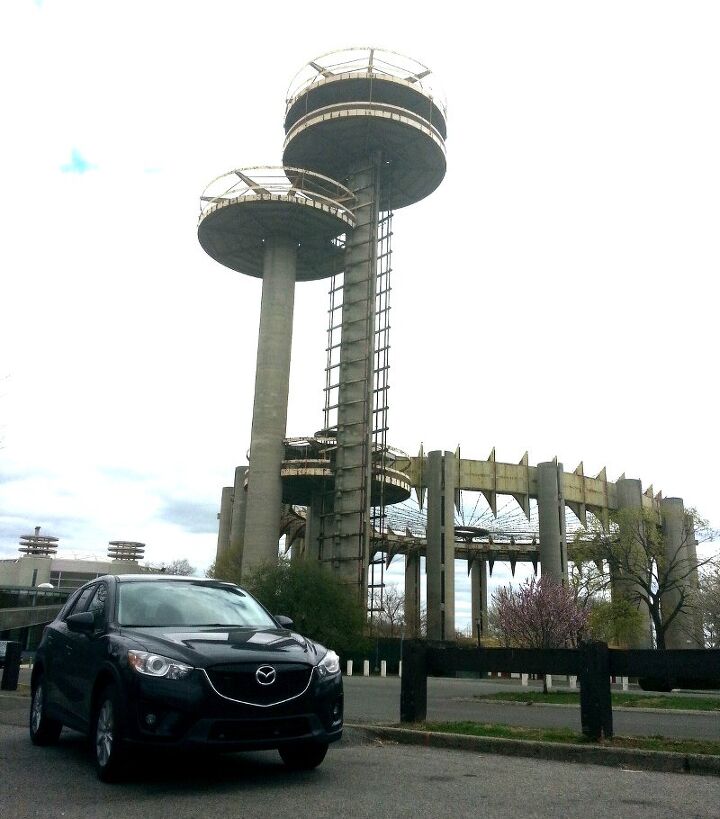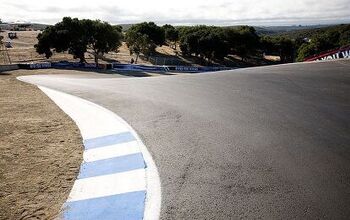Rental Review: 2014 Mazda CX-5 Touring AWD

Two years ago, I declared my undying affection for the Mazda CX-5. The “Skyactiv philosophy” cute-ute was, I reckoned, pretty close to perfect. There was just one little problem: although the manual-transmission variant shone in venues as diverse as Laguna Seca and the back roads surrounding Monterey, the CX-5 struggled a bit when its two-liter powerplant was combined with an automatic transmission. So what, right? Obviously the stick-shift is the one to have.
Since most people don’t feel that way, however, Mazda has decided to address the power issue by making its 2.5L, 184-horsepower engine standard equipment in Touring trim and above. To check out what difference the bigger mill makes on the road, I drove a CX-5 nearly twelve hundred miles in the course of seventy-two hours.
My trip took me from sunny Powell, Ohio to, um… is that Bangkok in the photo above? Perhaps it’s Kuala Lumpur, or Nairobi. Maybe this next shot will help.
Yes? No? Maybe? The Pepsi-Cola sign should be helpful. Let’s see it from another angle:
That’s Citi Field, home of the Mets. The CX-5 is, therefore, in the so-called “Iron Triangle” behind Citi, the unregulated, unpaved area where chop-shops and bootleg collision centers dominate the not-quite-urban landscape. The “Iron Triangle” is, I understand, not long for this world; too many people have their eyes on the real estate. You can read more about it on Slate. My six-foot-tall, unashamedly Dutch boon companion and professional urban planner, [name redacted], considers the area perhaps the most exciting part of New York. “It’s amazing, to see a place where nothing’s been done.” Then, referring to the city’s willful failure to provide the Iron Triangle with paved streets, city sewers, or electric lighting, she offered this: “Every Republican in this country should be dragged there to see what happens when you have little to no government involvement in daily life.”
One thing’s for certain: if you want to go off-roading within the five boroughs, this is your destination. The landscape abounds with foot-deep sinkholes, ruts, and crests created by the action of undrained rainwater across the dirt surface. Once or twice, I was able to get the Mazda to do some deliberate traction transfer to the rear wheels in order to get up a slippery hump. The locals, who avoid those areas as a matter of course, eyed me with suspicion. What kind of idiot would deliberately tackle stuff like that in a CUV?
The CX-5 is totally fine on rough surfaces, as long as you’re conscious of the ride height, but it was designed to operate on-road. A good thing, as I had a lot of road to cover during this trip, and I had to drive it all myself. I decided that I would deliberately compare this $26,215 four-cylinder car against the Grand Cherokee that won the Rental Grinders comparison a week ago. What do you lose for the $13,000 price gap to the JGC, and what, if anything, do you gain?
We all know that a transverse FWD platform pays dividends in all sorts of ways. Start with interior space utilization. The CX-5 is significantly smaller than the Grand Cherokee, losing half a foot in both length and wheelbase and four inches across the beam, but it doesn’t feel like it. All four passengers have at least as much usable room in the Mazda as in the Jeep, and cargo area was effectively identical. After the decidedly upscale interior and touch points of the Grand Cherokee, the CX-5 was functional at best — but nearly everything you touch feels acceptable for the segment. Some of it is a little over-designed, as with the turn signal and wiper switch that have J-shaped connectors to the steering column, but it’s all usable enough.
The Touring trim’s included center screen and stereo system are the easy equal of anything the Jeep or Ford Edge SEL have to offer; better, in fact, with more features and a more satisfying listening experience. The Bluetooth integration was a little frustrating; not only were phone conversations using my Samsung Galaxy S3 quite frustrating, the texting feature was completely useless.
Yeah, don’t bother with that. It doesn’t work. On the positive side, track and artist information were clearly and correctly displayed when using my phone as an audio device, and the directional buttons for track selection were functional as well.
A good stereo is a requirement for a long drive, but a good ride and low interior noise don’t hurt matters. Here, the CX-5 shone, matching the bigger utes for ride and beating the Edge on noise suppression. It had the measure of its rivals on manueverability, as well, particularly on the surface streets of Manhattan and Brooklyn where moving aggressively to find and fill gaps isn’t an optional behavior.
So far, that’s all the behavior I expected from the little-ish Mazda based on previous experience. The questions I had revolved around the pairing of the 2.5L Skyactiv and the six-speed automatic. We can start with the good news: On the 560-mile trip from Powell to Williamsburg, the CX-5 displayed an average 30.1mpg consumption figure, showing 30.3mpg all the way to the Holland Tunnel. I drove for economy, avoiding strong starts or kickdown-intensive passing, but I did run 75-80mph wherever possible.
On the way back, however, there was a strong headwind and I frequently found myself summoning fifth gear for climbs. Against the wind, so to speak, the CX-5 couldn’t maintain 80mph without dropping out of top gear. At the end of the return trip, therefore, the score stood as you see here:
Still not bad, right? And still about twenty percent better than what either the Edge or Grand Cherokee could manage. Make no mistake, though, the addition of the 2.5L didn’t make this CUV a rocketship. At best, it’s now quick enough to work with all traffic situations. If you want a fast vehicle in this segment, get the old V-6 RAV4, which fired off fifteen-second quarter-miles with no problem. This Mazda won’t come close to that.
It’s tempting to wish for a V-6 in this CUV, as well. But the CX-5 shines in large part because of the overall balance Mazda got from making it incompatible with a larger engine. Perhaps alone among its competitors, this is a vehicle of restraint and even taste. Just enough size, just enough motor, just enough features. At two-thirds of the price of the larger CUV competition, this vehicle offers a full share of their virtues, with some additional ones besides.
After two long days on the road, I remained convinced by the CX-5. It would really knock my socks off if Mazda could combine the six-speed manual with the bigger engine, but this Touring variant is more than good enough to see off the competition. The sticker price represents tremendous value and it continues to be recommended over the alternatives, from CR-V to Escape. If you really need more power, more curb appeal, and more off-road ability, you can choose the Grand Cherokee without regrets — but for the vast majority of buyers, this Five is enough.

More by Jack Baruth
Latest Car Reviews
Read moreLatest Product Reviews
Read moreRecent Comments
- Kjhkjlhkjhkljh kljhjkhjklhkjh A prelude is a bad idea. There is already Acura with all the weird sport trims. This will not make back it's R&D money.
- Analoggrotto I don't see a red car here, how blazing stupid are you people?
- Redapple2 Love the wheels
- Redapple2 Good luck to them. They used to make great cars. 510. 240Z, Sentra SE-R. Maxima. Frontier.
- Joe65688619 Under Ghosn they went through the same short-term bottom-line thinking that GM did in the 80s/90s, and they have not recovered say, to their heyday in the 50s and 60s in terms of market share and innovation. Poor design decisions (a CVT in their front-wheel drive "4-Door Sports Car", model overlap in a poorly performing segment (they never needed the Altima AND the Maxima...what they needed was one vehicle with different drivetrain, including hybrid, to compete with the Accord/Camry, and decontenting their vehicles: My 2012 QX56 (I know, not a Nissan, but the same holds for the Armada) had power rear windows in the cargo area that could vent, a glass hatch on the back door that could be opened separate from the whole liftgate (in such a tall vehicle, kinda essential if you have it in a garage and want to load the trunk without having to open the garage door to make room for the lift gate), a nice driver's side folding armrest, and a few other quality-of-life details absent from my 2018 QX80. In a competitive market this attention to detai is can be the differentiator that sell cars. Now they are caught in the middle of the market, competing more with Hyundai and Kia and selling discounted vehicles near the same price points, but losing money on them. They invested also invested a lot in niche platforms. The Leaf was one of the first full EVs, but never really evolved. They misjudged the market - luxury EVs are selling, small budget models not so much. Variable compression engines offering little in terms of real-world power or tech, let a lot of complexity that is leading to higher failure rates. Aside from the Z and GT-R (low volume models), not much forced induction (whether your a fan or not, look at what Honda did with the CR-V and Acura RDX - same chassis, slap a turbo on it, make it nicer inside, and now you can sell it as a semi-premium brand with higher markup). That said, I do believe they retain the technical and engineering capability to do far better. About time management realized they need to make smarter investments and understand their markets better.







































Comments
Join the conversation
The Mazda CX5 is simply a car that sets new standards. Though some may say a lot of negative things about the CX5, the fact that the engineers readjust the engine-gearbox map gives this car a lot to say under the hood. That's just me though.
Just bought a 2016 CX-5 Touring. So far, love it. The 2016 was worth waiting for with a bigger backup/infotainment screen, mildly improved ride and sound insulation, height adjustable passenger seat. Soul red with sand color seats. Interior is tweaked a bit nicer. Last, I have to object to your girlfriends comment: "Every Republican in this country should be dragged there to see what happens when you have little to no government involvement in daily life.” New Yorkers pay through the nose for an enormous joke of a Democrat government that regulates and taxes more than most other cities. Yet, Iron triangle exists. It must be the fault of...Libertarians!